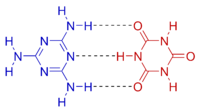Melamine cyanurate
 | |
| Names | |
|---|---|
| IUPAC name
1,3,5-Triazine-2,4,6(1H,3H,5H)-trione + 1,3,5-triazine-2,4,6-triamine (1:1) | |
| Other names
Melamine-cyanuric acid compound, melamine-cyanuric acid adduct, melamine cyanurate, melamine isocyanurate | |
| Identifiers | |
| 37640-57-6 70371-20-9 | |
| 3D model (Jmol) | Interactive image |
| ChemSpider | 84141 |
| ECHA InfoCard | 100.048.687 |
| MeSH | melamine+cyanurate |
| PubChem | 93198 |
| |
| |
| Properties | |
| C6H9N9O3
(C3H6N6·C3H3N3O3) | |
| Molar mass | 255.19 g/mol |
| none | |
| Except where otherwise noted, data are given for materials in their standard state (at 25 °C [77 °F], 100 kPa). | |
| | |
| Infobox references | |
Melamine cyanurate, also known as melamine-cyanuric acid adduct or melamine-cyanuric acid complex, is a crystalline complex formed from a 1:1 mixture of melamine and cyanuric acid. The substance is not a salt despite its non-systematic name melamine cyanurate. The complex is held together by an extensive two-dimensional network of hydrogen bonds between the two compounds, reminiscent to that seen in DNA base pairing.[2] Melamine cyanurate forms spoke-like crystals from aqueous solutions [3] and has been implicated as a causative agent for toxicity seen in the Chinese protein export contamination and the 2007 pet food recall.[3]
Chemistry
The substance is best described as a melamine-cyanuric acid co-crystallate, complex, or non-covalent adduct. The two compounds do not form a salt as suggested by its non-systematic trivial name melamine cyanurate.
Melamine and cyanuric acid form a jigsaw puzzle-like two-dimensional hydrogen bonding network because of the complementarity of the two compounds, similar to DNA base pairing.
Uses
Melamine cyanurate is commonly used as a fire retardant.
Toxicity
It has been considered to be more toxic than either melamine or cyanuric acid alone.[4]
LD50 in rats and mice (ingested):
- 4.1 g/kg - Melamine cyanurate
- 6.0 g/kg - Melamine
- 7.7 g/kg - Cyanuric acid
A toxicology study conducted after recent pet food recalls concluded that the combination of melamine and cyanuric acid in diet does lead to acute renal failure in cats.[5] A 2008 study produced similar experimental results in rats and characterized the melamine and cyanuric acid in contaminated pet food from the 2007 outbreak.[6]

See also
References
- ↑ EPA: Substance :
- ↑ Perdigão LM, Champness NR, Beton PH (2006). "Surface self-assembly of the cyanuric acid-melamine hydrogen bonded network". Chem. Commun. (5): 538–540. doi:10.1039/b514389f. PMID 16432575.
- 1 2 Lili He; Yang Liu; Mengshi Lin; Joseph Awika; David R Ledoux; Hao Li; Azlin Mustapha (2008). "A new approach to measure melamine, cyanuric acid, and melamine cyanurate using surface enhanced Raman spectroscopy coupled with gold nanosubstrates". Sens. & Instrumen. Food Qual. 2: 66–71. doi:10.1007/s11694-008-9038-0.
- ↑ A.A. Babayan, A.V.Aleksandryan, "Toxicological characteristics of melamine cyanurate, melamine and cyanuric acid", Zhurnal Eksperimental'noi i Klinicheskoi Meditsiny, Vol.25, 345-9 (1985). Original article in Russian.
- ↑ Puschner et al. (November 2007). Assessment of melamine and cyanuric acid toxicity in cats. Journal of Veterinary Diagnostic Investigation. Retrieved on 2007-11-16.
- ↑ Dobson; et al. (August 2008). "Identification and characterization of toxicity of contaminants in pet food leading to an outbreak of renal toxicity in cats and dogs.". Toxicological Sciences. Retrieved 2009-08-13.